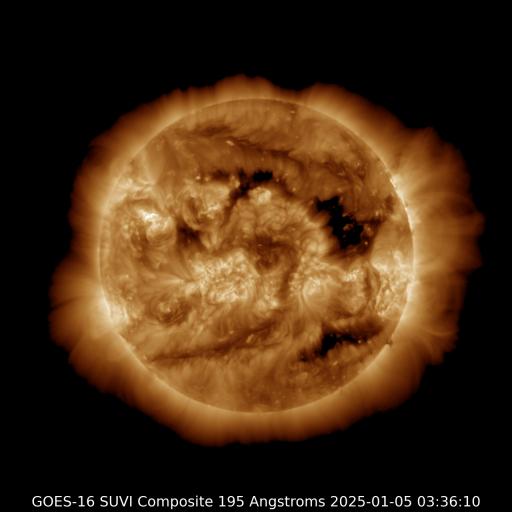Viewing archive of Saturday, 13 October 2012
Solar activity report
Any mentioned solar flare in this report has a scaling factor applied by the Space Weather Prediction Center (SWPC). Because of the SWPC scaling factor, solar flares are reported as 42% smaller than for the science quality data. The scaling factor has been removed from our archived solar flare data to reflect the true physical units.
Report of Solar-Geophysical Activity 2012 Oct 13 2200 UTCPrepared by the NOAA © SWPC and processed by SpaceWeatherLive.com
Joint USAF/NOAA Report of Solar and Geophysical Activity
SDF Number 287 Issued at 2200Z on 13 Oct 2012IA. Analysis of Solar Active Regions and Activity from 12-2100Z to 13-2100Z
Solar activity was very low. Region 1589 (N13E22) is
the most magnetically complex spot group on the visible disk with a
Beta-Gamma-Delta magnetic configuration. No Earth-directed CMEs
were observed during the reporting period.
IB. Solar Activity Forecast
Solar activity is expected to be low
with a chance for M-class flares and a slight chance for X-class
flares during the forecast period (14-16 October).
IIA. Geophysical Activity Summary 12-2100Z to 13-2100Z
The geomagnetic field ranged from quiet to minor storm levels with
major to severe storm periods observed at high latitudes. The
period began with quiet to unsettled conditions through 13/0300Z. A
sustained period of southward Bz to -11 nT for approximately 13
hours resulted in active to minor storm conditions with major to
severe storm periods at high latitudes. At about 13/0650Z, the phi
angle changed from a negative (toward) orientation to a positive
(away) orientation, indicating a solar sector boundary crossing.
This was followed by increases in density, temperature, and solar
wind speed indicative of a co-rotating interaction region in advance
of a coronal hole high speed stream (CH HSS). By 13/1618Z, solar
wind speed increased from approximately 530 km/s to 590 km/s while
the total magnetic field (Bt) decreased to 5 nT as the CH HSS became
geoeffective. The greater than 2 MeV electron flux at geosynchronous
orbit reached high levels during the period.
IIB. Geophysical Activity Forecast
The geomagnetic field is
expected to continue at unsettled to active levels with a chance for
isolated minor storm periods on day 1 (14 October). Mostly
unsettled conditions are expected on day 2 (15 October) due to
persistence. By day 3 (16 October), quiet to unsettled conditions
are expected as coronal hole effects wane. On days 2-3, there is a
slight chance for a greater than 10 MeV proton event at
geosynchronous orbit as Region 1589 rotates into a more geoeffective
position.
III. Event Probabilities 14 Oct to 16 Oct
| Class M | 35% | 35% | 35% |
| Class X | 10% | 10% | 10% |
| Proton | 05% | 10% | 10% |
| PCAF | green | ||
IV. Penticton 10.7 cm Flux
Observed 13 Oct 125 Predicted 14 Oct-16 Oct 125/130/130 90 Day Mean 13 Oct 117
V. Geomagnetic A Indices
Observed Afr/Ap 12 Oct 012/014 Estimated Afr/Ap 13 Oct 025/036 Predicted Afr/Ap 14 Oct-16 Oct 016/018-011/012-007/010
VI. Geomagnetic Activity Probabilities 14 Oct to 16 Oct
| A. Middle Latitudes | |||
|---|---|---|---|
| Active | 30% | 30% | 15% |
| Minor storm | 20% | 10% | 05% |
| Major-severe storm | 05% | 01% | 01% |
| B. High Latitudes | |||
|---|---|---|---|
| Active | 10% | 15% | 15% |
| Minor storm | 25% | 30% | 20% |
| Major-severe storm | 55% | 40% | 20% |
All times in UTC
Latest news
Latest forum messages
New satellites - Proba-3, PUNCH, SWFO-L1, GOES-U/19 47Incoming & Unnumbered Active Regions 1673AR 4054 21AR4048 124Unspecified geomagnetic activity 2229
More topicsSupport SpaceWeatherLive.com!
A lot of people come to SpaceWeatherLive to follow the Sun's activity or if there is aurora to be seen, but with more traffic comes higher server costs. Consider a donation if you enjoy SpaceWeatherLive so we can keep the website online!

Latest alerts
06:30 UTC - Type II Radio Emission
Begin Time: 08/04/2025 05:53 UTC Estimated Velocity: 456km/sec.
05:15 UTC - Hemispheric Power Index
The OVATION model predicts the Hemispheric Power Index to reach 50GW at 06:02 UTC
00:55 UTC - Coronal hole
A southern hemisphere coronal hole is facing Earth. Enhanced solar wind could arrive in ~3 days
Monday, 7 April 2025
20:45 UTC - Geomagnetic activity
Active geomagnetic conditions (Kp4) Threshold Reached: 20:39 UTC
17:33 UTC - Hemispheric Power Index
The OVATION model predicts the Hemispheric Power Index to reach 51GW at 18:18 UTC
Space weather facts
| Last X-flare | 2025/03/28 | X1.1 |
| Last M-flare | 2025/04/05 | M1.0 |
| Last geomagnetic storm | 2025/04/06 | Kp5 (G1) |
| Spotless days | |
|---|---|
| Last spotless day | 2022/06/08 |
| Monthly mean Sunspot Number | |
|---|---|
| March 2025 | 134.2 -20.4 |
| April 2025 | 151.3 +17.1 |
| Last 30 days | 135.2 -4.5 |




